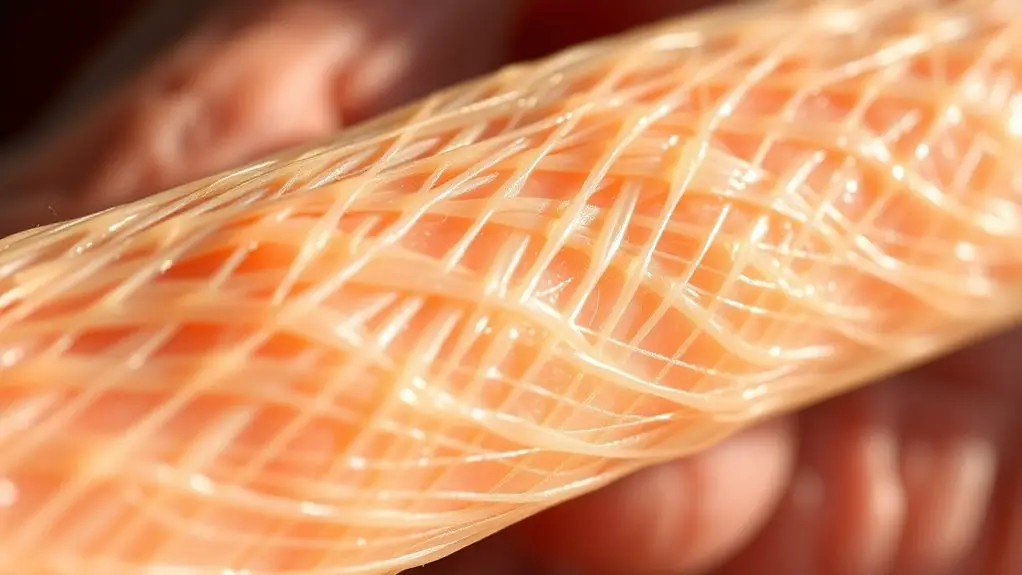Foot arch strength is essential for your overall performance, impacting balance and power generation. Strong arches help absorb shock and improve gait efficiency, while weak arches can lead to injuries like shin splints and plantar fasciitis. By knowing your foot arch type and incorporating targeted exercises, you can boost arch strength and enhance athletic output. Remember, choosing the right footwear also plays an important role. Discover more about optimizing your foot health and performance as you continue exploring.
Understanding the Anatomy of the Foot
The foot is a complex structure, housing 26 bones, numerous muscles, and ligaments that work together to support your body. Understanding foot anatomy is essential for anyone seeking to release themselves from discomfort and enhance performance. Your foot's arch structure plays an important role in this. It acts like a spring, absorbing shock and providing stability as you move.
Each arch—medial, lateral, and transverse—contributes to your overall balance and agility. When your arches are strong and well-aligned, you'll feel the difference in how you walk, run, or engage in any activity. Incorporating flexibility and mobility work into your routine can further enhance the function of your arches.
Neglecting your foot's anatomy can lead to imbalances and pain, limiting your freedom to explore and enjoy life fully. By focusing on strengthening your foot's arches and understanding their role, you'll access your potential for movement, allowing you to experience life with greater ease and confidence.
The Different Types of Foot Arches
When it comes to foot arches, you'll find two main types: high arches and flat arches. High arches often lead to less shock absorption, while flat arches can cause overpronation. Understanding these characteristics can help you choose the right footwear for your activities.
High Arch Characteristics
While many people may not pay much attention to their foot arches, understanding high arch characteristics can reveal important insights about foot health and performance. If you have a high arch, you might experience:
- High Arch Benefits: You're likely to enjoy better shock absorption and agility.
- Foot Pain: Some high arches can lead to discomfort in the heels or balls of your feet.
- Injury Risks: Increased risk of conditions like plantar fasciitis and ankle sprains.
- Footwear Needs: You may require specially designed shoes or orthotics for support.
Recognizing these aspects helps you embrace your unique foot structure, allowing you to train effectively while minimizing high arch challenges. Ultimately, understanding your foot's needs can enhance your freedom and performance.
Flat Arch Features
Understanding flat arch features is essential for anyone looking to optimize their foot health and athletic performance. Flat arches, while often seen as a challenge, come with unique flat arch benefits. For instance, they allow for greater flexibility and adaptability during movement, making activities like dancing or yoga more accessible. However, you may face flat arch challenges, such as increased pronation and potential discomfort during high-impact activities. It's vital to recognize these aspects to tailor your footwear and exercise routines effectively. Embracing the strengths of your flat arches can lead to improved stability and balance, empowering you to move freely and confidently. So, take charge of your foot health and enjoy the journey toward peak performance!
The Role of Foot Arches in Biomechanics
Your foot arches play an essential role in how your body moves and absorbs shock during activities. They influence your gait mechanics, affecting everything from balance to speed. Understanding different arch types can help you optimize performance and reduce the risk of injury.
Importance of Foot Arches
Although often overlooked, foot arches play an essential role in biomechanics, influencing how we move and perform daily activities. Understanding their importance can help you appreciate the freedom your feet provide. Here are a few key benefits of foot arches:
- Shock Absorption: Arches help cushion impacts, reducing stress on your joints.
- Stability: They provide balance, enhancing your ability to navigate various terrains.
- Movement Efficiency: With proper arch support, you can move more fluidly and conserve energy.
- Arch Flexibility: A flexible arch adapts to different surfaces, improving overall performance.
Impact on Gait Mechanics
When you walk or run, the arches of your feet play a crucial role in determining how efficiently and effectively you move. They act as natural springs, absorbing shock and providing stability, which directly impacts your gait mechanics. Gait analysis reveals that well-developed arches enhance your stride, allowing for smoother shifts and better energy transfer. If your arches lack flexibility, you might struggle with balance, leading to inefficient movement patterns. This can cause undue strain on your joints and muscles, affecting your overall performance. By focusing on improving arch strength and flexibility, you can access your body's true potential and enjoy a more liberated, fluid motion with every step you take. Your feet deserve the freedom to perform at their best!
Arch Types and Performance
Understanding the different types of foot arches is essential for optimizing performance, as each arch type plays a distinct role in biomechanics. Here's how your arch type can impact your arch performance and flexibility:
- High Arch: Offers less flexibility, which can lead to stiffness; perfect for athletes needing stability.
- Normal Arch: Balances flexibility and support, promoting efficient energy transfer during movement.
- Flat Arch: Provides maximum flexibility but can cause overpronation; great for those who need adaptive motion.
- Flexible Arch: Adapts easily to surfaces, enhancing grip and shock absorption; ideal for dynamic sports.
How Arch Strength Affects Athletic Performance
As you push your limits in any athletic endeavor, the strength of your foot arch plays an essential role in your overall performance. Strong arches provide the necessary arch support that enables your feet to absorb shock and distribute weight effectively. This not only enhances your stability but also boosts your agility, allowing you to move freely and confidently.
When your arches are strong, you're better equipped to maintain proper alignment and engage your muscles efficiently. This results in improved endurance and speed, key factors in any sport. Performance enhancement comes from the ability to generate power and sustain it over time, and a robust foot arch is vital for that.
Common Injuries Related to Weak Foot Arches
Weak foot arches can lead to a variety of common injuries that may sideline athletes and active individuals alike. When your arches aren't doing their job, you're at risk for discomfort and pain. Here are some injuries to watch out for:
Weak foot arches can cause discomfort and injuries that affect your active lifestyle. Stay aware and take action!
- Shin splints – pain along the shin, often from overuse.
- Plantar fasciitis – irritation of the tissue on the bottom of your foot, causing heel pain.
- Achilles tendonitis – inflammation of the Achilles tendon, leading to stiffness and pain.
- Metatarsalgia – pain in the ball of your foot, often aggravated by weak arches.
Other issues like foot cramps, neuromas, stress fractures, ankle instability, and sesamoid injuries can also arise. Keeping your arches strong is essential for staying active and enjoying life without limitations. Additionally, proper warm-ups before engaging in physical activity can help prevent these injuries. Don't let weak foot arches hold you back!
Assessing Your Foot Arch Type and Strength
How can you determine your foot arch type and strength? Start with a simple foot assessment. Wet your foot and step onto a piece of paper, leaving a footprint. If you see a wide band connecting the heel and toe, you likely have flat arches. A narrow band suggests high arches, while a moderate band indicates neutral arches.
Next, consider your arch strength. You can perform an arch evaluation by standing on one foot and observing how your foot holds its shape. If it collapses inward, your arch may lack strength.
You can also test your arches by walking barefoot on various surfaces. Notice how your feet feel—do they tire quickly or feel stable? Understanding your foot's unique structure is essential for freedom in movement and peak performance. Embrace this knowledge to enhance your activities and reduce the risk of injury.
Exercises to Strengthen Foot Arches
To strengthen your foot arches effectively, incorporating specific exercises into your routine can make a significant difference. Embracing arch strengthening techniques and foot stability exercises will help you feel freer and more agile. Here are four exercises to get you started:
Incorporate targeted exercises into your routine to enhance foot arch strength and stability for greater agility.
- Toe Raises: Stand tall and lift your heels off the ground while keeping your toes planted. Hold for a few seconds and lower back down.
- Arch Lifts: While seated, try to lift the arch of your foot without curling your toes. Hold for a few seconds and release.
- Marble Pickup: Use your toes to pick up marbles or small objects from the floor. This boosts coordination and strength.
- Towel Scrunches: Place a towel on the floor and use your toes to scrunch it toward you, engaging the muscles in your arches.
Integrate these exercises into your daily routine, and you'll notice improved foot strength and stability.
The Impact of Footwear on Arch Strength
While choosing the right footwear might seem like a minor detail, it can greatly influence your foot arch strength and overall stability. The materials used in your shoes play an essential role in determining how well your arches are supported. For instance, shoes with inadequate arch support can lead to weakness over time, making your feet more prone to injuries.
When you wear shoes made from flexible, breathable materials, you allow your feet to move naturally. This flexibility can enhance your arch strength by promoting muscle engagement. On the flip side, overly rigid footwear can restrict your foot's natural motion, hindering the development of strong arches.
Opting for footwear that combines comfort with proper arch support can empower your feet. So, next time you pick out a pair of shoes, consider how they'll affect your arch strength and embrace the freedom of strong, healthy feet.
Tips for Maintaining Healthy Foot Arches
Maintaining healthy foot arches goes beyond simply choosing the right footwear. It's about actively taking care of your feet to guarantee they support your freedom to move. Here are some tips for effective foot care:
Taking care of your feet is essential for maintaining healthy arches and supporting your active lifestyle.
- Choose Proper Arch Support: Invest in shoes with good arch support, especially if you're on your feet a lot. Your arches need that boost to stay strong.
- Stretch Regularly: Incorporate foot and calf stretches into your routine. This helps maintain flexibility and reduces tension in your arches.
- Strengthen Your Feet: Perform exercises that target your foot muscles, like toe curls or picking up marbles with your toes. Strong feet lead to healthier arches.
- Listen to Your Body: Pay attention to any discomfort. If you feel pain in your arches, don't ignore it; rest and consult a professional if needed.
Additionally, prioritizing mobility training can improve your overall movement efficiency and help maintain foot health.
With these simple steps, you can keep your arches happy and strong!
Frequently Asked Questions
Can Foot Arch Strength Improve Balance and Stability?
Yes, foot arch strength can definitely improve your balance and stability. By incorporating arch exercises into your routine, you're not just strengthening your feet, but also enhancing your overall stability training. This allows you to move more freely and confidently, whether you're running, jumping, or just walking. Stronger arches mean better support for your body, which can lead to a more balanced and liberated experience in your everyday activities.
How Does Age Affect Foot Arch Strength?
As the saying goes, "You can't teach an old dog new tricks." Age-related changes in foot structure can greatly impact your arch strength. As you age, ligaments and tendons may lose elasticity, leading to flattened arches and reduced support. This can affect your balance and stability, making it essential to pay attention to your foot health. Embracing exercises that strengthen your arches can help maintain freedom of movement, no matter your age.
Do Flat Feet Require Special Considerations in Training?
If you have flat feet, it's crucial to make some training modifications to avoid discomfort and injury. You might want to focus on strengthening exercises that target the muscles in your feet and lower legs. Incorporating supportive footwear can also help. Don't shy away from activities; just listen to your body and adjust your routine as needed. With the right approach, you can enjoy your workouts while keeping your feet happy and healthy!
Can Weight Gain Impact Foot Arch Health?
Yes, weight gain can impact your foot arch health. As your body weight increases, it alters weight distribution, placing more stress on your arches. This added pressure can lead to discomfort or potential issues if your arches aren't well-supported. You might want to reflect on proper arch support in your footwear to help maintain comfort and function. Keeping your feet happy is essential for enjoying your freedom to move and explore!
Are There Genetic Factors Influencing Foot Arch Types?
Yes, there're definitely genetic factors influencing foot arch types. Your arch morphology can be shaped by genetic inheritance from your parents, affecting its height and flexibility. If you've got a family history of flat or high arches, you might find yourself with similar traits. Embracing your unique foot structure can help you choose the right footwear and activities, allowing you the freedom to move comfortably and confidently in your daily life.




